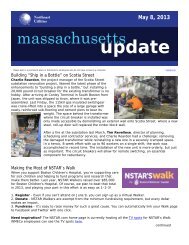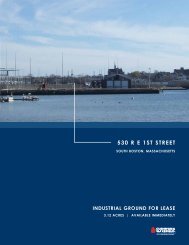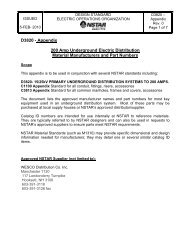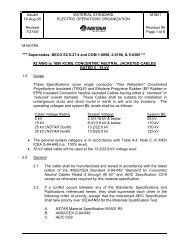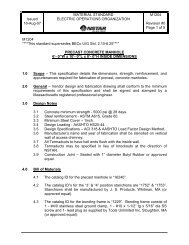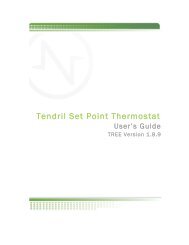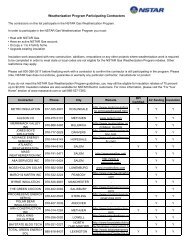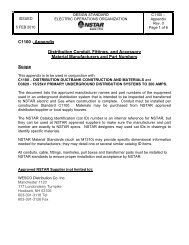INFORMATION & REQUIREMENTS ELECTRIC SERVICE - NStar
INFORMATION & REQUIREMENTS ELECTRIC SERVICE - NStar
INFORMATION & REQUIREMENTS ELECTRIC SERVICE - NStar
You also want an ePaper? Increase the reach of your titles
YUMPU automatically turns print PDFs into web optimized ePapers that Google loves.
ARTICLE 802<br />
TABLE 2<br />
Three Phase Motors<br />
Maximum Locked Rotor Current Values in Amperes<br />
This table is based on not more than four starts per hour with<br />
long periods of continuous operation under maximum load<br />
conditions. Contact the NSTAR New Customer Connect Tech<br />
Center where these conditions cannot be met, or where<br />
equipment rating and/or starting characteristics exceed the<br />
following:<br />
A. Equipment with motors rated in horsepower<br />
Rated at<br />
Maximum locked rotor current<br />
208* volts, three phase, 57.5 amps<br />
2 hp or less<br />
2.5 to 19.9 hp 57.5 amps per hp in excess of 2 hp<br />
Over 19.9 hp<br />
Contact the NSTAR Tech Center<br />
B. Air Conditioning or Heat Pump Equipment rated in<br />
btu per hour<br />
Rated at<br />
Maximum locked rotor current<br />
208* volts, three phase, 57.5 amps<br />
20,000 btu/h or less<br />
21,000 – 50,000 btu/h 57.5 amps plus 1.15 amps per<br />
1,000 btu/h in excess of 20,000 btu/h<br />
51,000 – 225,000 btu/h 144 amps plus 1.15 amps per<br />
1,000 btu/h in excess of 50,000 btu/h<br />
Over 225,000 btu/h<br />
Contact the NSTAR Tech Center<br />
ARTICLE 803<br />
803. Motor Protection<br />
A. Protective Devices General<br />
NSTAR strongly recommends that all motor installations<br />
be adequately protected to prevent improper operation,<br />
equipment damage and personal injury which might result<br />
from abnormal conditions occurring in NSTAR’s service<br />
facilities or the customer’s wiring system.<br />
B. Protection Against Single Phase Operation<br />
Three phase motors shall be protected against the<br />
possibility of loss of any phase of the supply circuit.<br />
NSTAR does not provide protection against loss of phase<br />
conditions.<br />
C. Undervoltage Protection<br />
All motors requiring protection against the application of<br />
full voltage at starting, or motors that would endanger life<br />
and/or property by restarting after a service interruption<br />
and a return to normal voltage shall be provided with<br />
undervoltage protection. Such protection devices should<br />
ensure that, with either undervoltage or no voltage, the<br />
motor will be disconnected from the line or the starter<br />
will be returned to the “off ” position.<br />
NSTAR recommends the use of time-delay undervoltage<br />
protection since instantaneous undervoltage protection<br />
may operate on momentary voltage fluctuations.<br />
D. Overload Protection<br />
All motors shall be protected against overload by the<br />
installation of adequate overcurrent thermal protective<br />
devices or their equivalent, which operate to prevent<br />
excessive motor winding temperatures.<br />
* For 480 volts multiply current by 0.435<br />
98<br />
99



